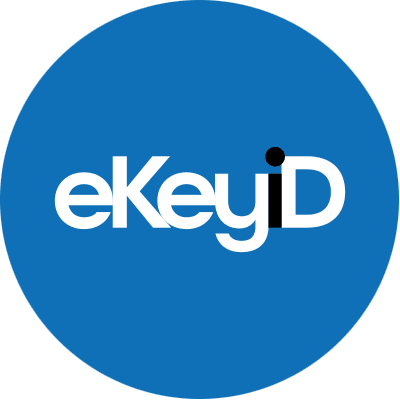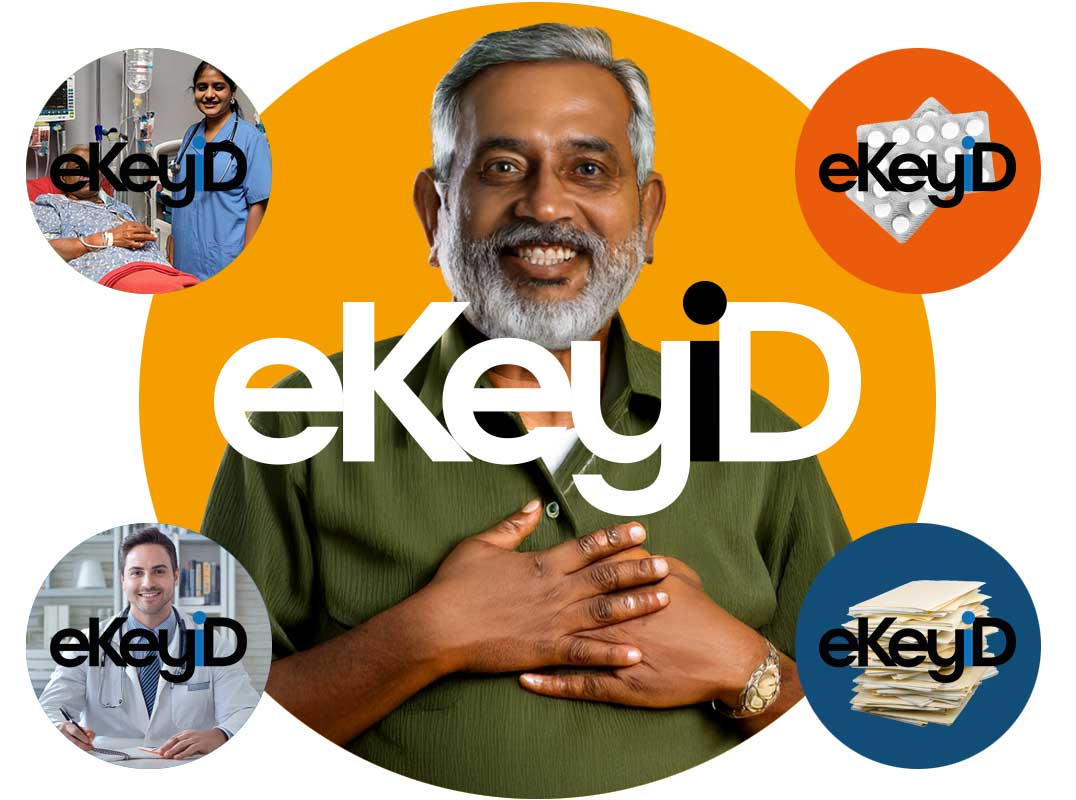Every patient has a unique identifier. Every drug has a unique batch number. Every oximeter has a serial number, a calibration record and an electrical test reference. Every supply is accompanied by an invoice…
But each of those identities occupies a different space and format. None of them is universally linked to all the other elements to which they relate. In such a complex, interrelated landscape, administering so many moving parts is a challenge that consumes cost and invites error and inefficiency. Come with us while we explain an easier approach…

The identity story begins with the eKeyiD. It’s a deceptively simple piece of wizardry that identifies anything - and we do mean anything - via a short code. Nothing particularly groundbreaking there, we admit, but this simple beginning opens out to a huge landscape.
Every eKeyiD can contain an unlimited volume of information, stored ultra-securely on your private node (or nodes) of our patented federated ledger. We’ll tell you more about this in a moment. Now the magic begins…
An eKeyiD can contain other eKeyiDs, and any eKeyiD can be contained inside an unlimited number of other keys. If that sounds complicated, it’s because it is - but using it couldn’t be simpler.
The following anonymised case study shows a typical situation where a patient with multiple conditions requires out-of-area care. When implemented, the single patient record will greatly alleviate the problems, but deployment of eKeyiD now could provide a solution almost immediately, funded by the savings it achieves. And when the single patient record becomes available, eKeyiD will greatly simplify its use.
Mr Patel is a 67-year-old man living in the Midlands. He has multiple long-term conditions including type 2 diabetes, chronic kidney disease (CKD stage 3), ischaemic heart disease, and moderate COPD. He takes more than ten medications daily and receives care from several different providers:
Mr Patel is widowed and sometimes struggles to keep track of his appointments and medications.

While visiting his daughter in London, Akash Patel developed breathlessness and presented to a local A&E. The clinicians there had no access to his full medication list or recent test results. Akash could not recall all his medications accurately. As a result, he was prescribed a high-dose diuretic for suspected heart failure exacerbation. He had recently been advised by his renal clinic to avoid this dose due to worsening kidney function, but this information wasn't available. Within days, his kidney function deteriorated significantly, leading to an unplanned hospital admission.
The London hospital discharged Akash back to his GP with a summary letter, but this took two weeks to reach his Midlands GP practice. In the meantime, the renal clinic (who were unaware of the hospital stay) scheduled him for routine follow-up, where staff were surprised to find acute deterioration in blood results. They had no access to the London discharge summary or treatment decisions.
Akash underwent repeat echocardiograms and blood tests in both the renal and cardiology services. These duplicated tests were stressful for him and costly for the NHS.
The lack of joined-up information resulted in:
Akash's case highlights the risks of fragmented records across NHS providers. Without a single source of information, clinicians had incomplete information at critical decision-making moments. This led to:
A unified patient record across all NHS providers would have:
For patients like Akash with complex, multi-system needs, fragmented health records directly contribute to poorer outcomes. A unified national patient record would not only reduce risks and inefficiencies but also restore trust and confidence in care continuity.
The case study above shows a clear case for a single patient record. The NHS is devoting considerable focus and funding to implementing this important project. But how long will that take, and how much will it cost? Given the demands on the NHS's limited budget, what else must be sacrificed to make it possible? The eKeyiD platform can connect all of these disparate parts within their existing systems within a matter of a few months, at a tiny fraction of the cost, disruption and delay of a system-wide rethink. It's effectively a universal translator that allows everyone to work the way they do at the moment - no retrianing or disruption required - and yet share information seamlessly and securely as though they were all connected to the same enterprise system.
…and so, for that matter, is efficiency. In business, we need to know our customers, our suppliers and all the infrastructure providers that allow us to deliver or require us to comply. In our personal lives, we defend our privacy, but every organisation is made up of people who need to be identified to comply with the law and to allow key processes like payments and banking.
We tend to think of privacy as a personal issue, but businesses need to keep their secrets too. They may not be protected by privacy regulations, but we see no reason why they shouldn’t receive the privilege of commercial confidence. Privacy, whether personal or commercial, should follow the decisions of the data owner.
Know-your-customer is a required element of financial compliance, but it’s equally important in business-to-business commerce. If every company offered a view of its credentials with potential customers or suppliers then their proposition would become instantly more persuasive.
Hour, days or even weeks can be wasted in the to-and-fro of requests for information. That not only upsets customers, it slows down settlement and soaks up inordinate amounts of resource. And that means expense. None of us can afford to accept this as “the way it is”.
All this talk of transparency and sharing may sound like an admirable aim, but what about securing the data to restrict just how much is to be revealed, and to whom? And, given that privacy must be maintained, how can it be secured?
We saw a need to raise the security bar beyond traditional databases and blockchain and operate DotLedger, our patented federated ledger, that sets new standards in security, running costs and environmental sustainability.

The eKeyiD, or rather the eKeyiDs, are compact, intelligent codes that identify almost any type of information, from an individual to a virtual account, a digital token or a transaction. They can be nested, grouped or overlapped with infinite flexibility, yet they can be shared through any existing technology without the need for system changes. So, for example, SWIFT can communicate unlimited gigabytes of documentation within a small fraction of its 140-character payment information capacity.
CertiQi Limited
Emperor's Gate
114a Cromwell Road
London
United Kingdom
SW7 4AG
Copyright ©2025, CertiQi Limited